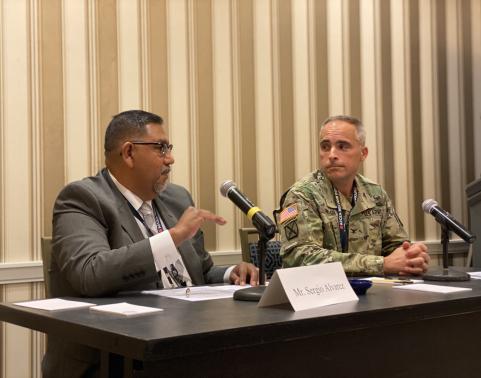APEO Networks Panel: Communications, Collaboration Are Key to Unified Network Success

As the Army Deputy Chief of Staff, G-6, Lt. Gen. John Morrison, pointed out in a Nov. 4 keynote speech at AFCEA Belvoir Industry Days (ABID), “Complexity is not our friend” in building the unified network, “but it’s not the enemy either.”
PEO EIS’s Networks, Cyber and Services (NCS) portfolio is deeply involved in the Army’s unified network effort, and during a Nov. 3 panel discussion at ABID, leaders from the portfolio shared some ways in which communications and collaboration are helping reduce the complexity and enormity of their task.
As EIS’s assistant program executive officer (APEO) for NCS, John Howell assists the three project management offices involved in setting the conditions for the unified network — Defense Communications and Army Transmission Services (DCATS), Defensive Cyber Operations (DCO) and Enterprise Services (ES). Because of their critical, interlinked role in the endeavor, Howell ensures that “cross-talk is happening when it needs to” among his project management teams and serves as EIS’s primary liaison with the Army’s Network Cross-Functional Team director.
“The function of the APEO needs to — and is — getting leaner and more adaptive,” said Howell. “It is more pertinent now than ever, and my duty is to be as lean and agile as possible. I rely heavily on my relationships with the three project managers and their teams; they are the ones who make it all happen.”
Communications and collaboration among the military services are also pivotal to unified network success. DCATS Project Manager Col. Jay Shell noted that each of the services has its own version of the Enterprise IT as a Service program, which will help inform network convergence. “We’re all in cross-talks,” he said. Among other unified network-enabling activities, Shell’s organization is tasked with modernizing the Army’s classified network by harnessing commercial technologies like 5G.
Similarly, Col. Mark Taylor, project manager for DCO, said that most of the military services have a big data platform — like the Army’s Gabriel Nimbus — which links the tactical and strategic sides of the enterprise network. DCO’s Lower Echelon Analytic Platform, known as LEAP, will ensure that the big data platform is enabled on the tactical network for unified network operations. “There is a lot of room for cooperation among the services,” said Taylor, noting that he plans to meet his Air Force counterpart soon to exchange ideas.
For EIS’s ES project management office, “working with stakeholders to get dollars behind programs” like identity, credential and access management (ICAM) is a key priority, according to ES’s Acting Project Director Sergio Alvarez. ICAM is one of the technologies that the Army G-6 considers foundational for the unified network. ES recently asked industry to respond to a request for information about commercial ICAM capabilities.
Companies interested in sharing their thoughts and ideas about network modernization or upcoming PEO EIS procurements can request a meeting.
Related News
-
Jason Morneault assumes command of Wideband Enterprise Satellite Systems
August 22, 2023On June 30, Project Manager Integrated Enterprise Network (IEN) conducted an assumption of charter ceremony for the Wideband Enterprise Satellite Systems (WESS) Product Management Office. -
Joe David values determination, hands-off leadership and family
June 27, 2023“You must want it mentally and you must show it physically, giving it your all.”
As an aspiring high school football player, Joe David received this advice from his father.
-
Darius White Explains the Power of Storytelling
April 26, 2023“Storytelling is a way to connect with people, even if it is fanciful or scientific, on another level,” said Darius White.
Work for Us
Join a winning team! Search for job opportunities with PEO Enterprise.
Work with Us
Help support important missions. Explore ways your company can work with PEO Enterprise.